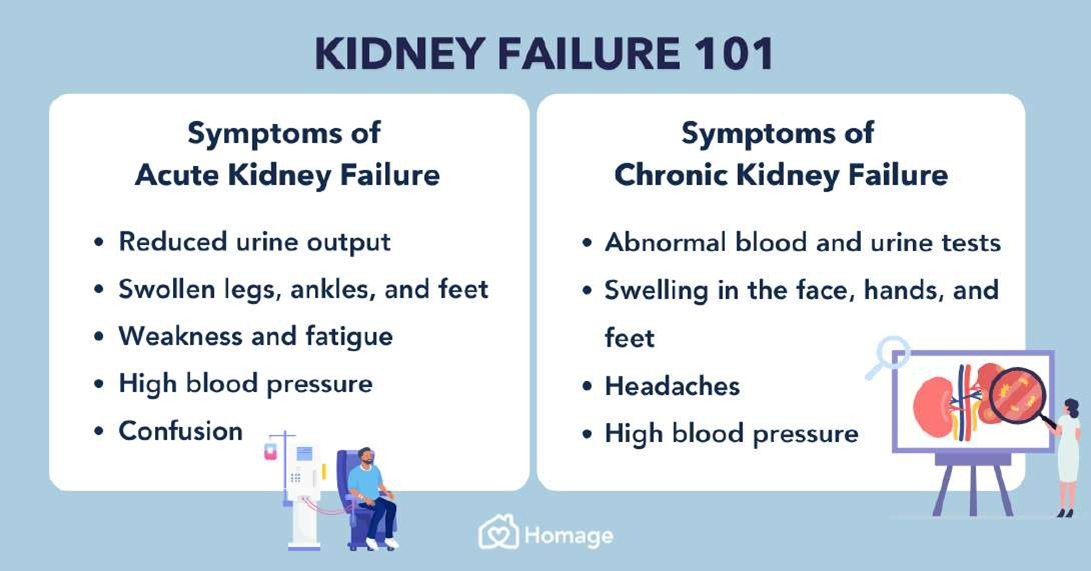A nurse is reviewing laboratory findings for four clients. Which of the following clients has manifestations of acute kidney injury?
Hemoglobin 16 g/dL
BUN 15 mg/dL
Serum potassium 4.5 mEq/L
Serum creatinine 6 mg/dL
The Correct Answer is D
Choice A reason: A hemoglobin level of 16 g/dL is within the normal range and does not indicate acute kidney injury.
Choice B reason: A BUN level of 15 mg/dL is also within the normal range and does not suggest acute kidney injury.
Choice C reason: A serum potassium level of 4.5 mEq/L is within the normal range and is not indicative of acute kidney injury.
Choice D reason: A serum creatinine level of 6 mg/dL is significantly elevated and indicates impaired kidney function, which is a hallmark of acute kidney injury.

Nursing Test Bank
Naxlex Comprehensive Predictor Exams
Related Questions
Correct Answer is A
Explanation
The correct answer is Choice A
Choice A rationale: Headache and restlessness can be signs of a seizure or neurological disturbance, which phenytoin is used to treat. Phenytoin is an anticonvulsant medication that helps control seizures by stabilizing neuronal membranes and reducing excitability.
Choice B rationale: Decreased blood pressure and rapid pulse are not indications for phenytoin administration. These symptoms may suggest hypotension or cardiovascular issues, which require different interventions such as fluid resuscitation or vasopressors.
Choice C rationale: Muscle cramps and chest heaviness are not treated with phenytoin. These symptoms could indicate electrolyte imbalances or cardiac issues, which need specific treatments like electrolyte replacement or cardiac monitoring.
Choice D rationale: Pain and tingling at the access site are not indications for phenytoin administration. These symptoms may suggest local irritation or infection at the dialysis access site, requiring appropriate wound care or antibiotics.
Correct Answer is A
Explanation
Choice A reason: In acute kidney injury (AKI), the blood urea nitrogen (BUN) level is expected to be elevated due to the kidneys' impaired ability to excrete urea, which is a waste product of protein metabolism. Normal BUN levels range from approximately 7 to 20 mg/dL.
Choice B reason: Hypercalcemia is not commonly associated with AKI. Instead, patients with AKI may experience hypocalcemia due to the kidneys' reduced ability to convert vitamin D to its active form, which is necessary for calcium absorption.
Choice C reason: Metabolic alkalosis is not a typical finding in AKI. More commonly, patients with AKI experience metabolic acidosis because the kidneys are unable to excrete acid effectively, leading to an accumulation of acid in the body.
Choice D reason: Hypokalemia is generally not expected in AKI. The condition is more often associated with hyperkalemia, as the impaired kidney function leads to a reduced excretion of potassium, which can accumulate to dangerous levels.
Whether you are a student looking to ace your exams or a practicing nurse seeking to enhance your expertise , our nursing education contents will empower you with the confidence and competence to make a difference in the lives of patients and become a respected leader in the healthcare field.
Visit Naxlex, invest in your future and unlock endless possibilities with our unparalleled nursing education contents today
Report Wrong Answer on the Current Question
Do you disagree with the answer? If yes, what is your expected answer? Explain.
Kindly be descriptive with the issue you are facing.
